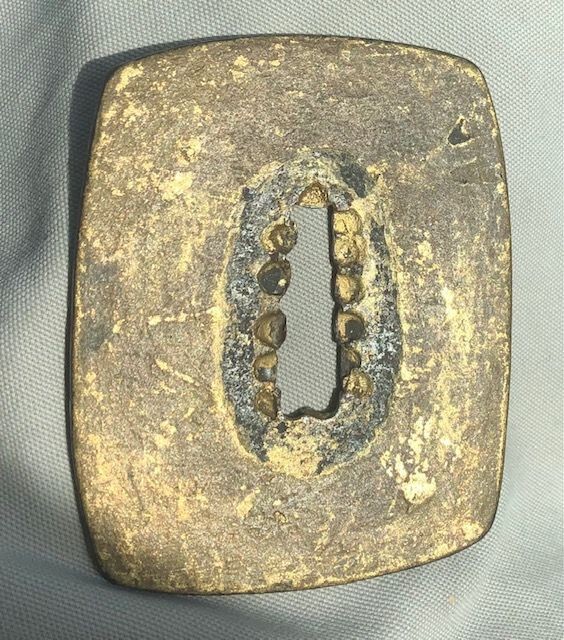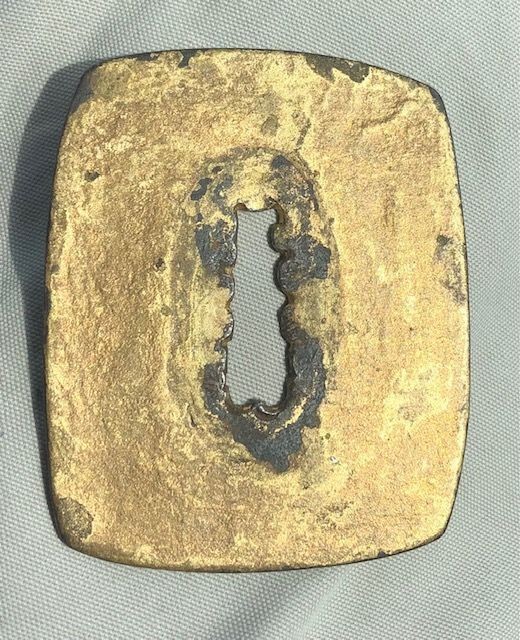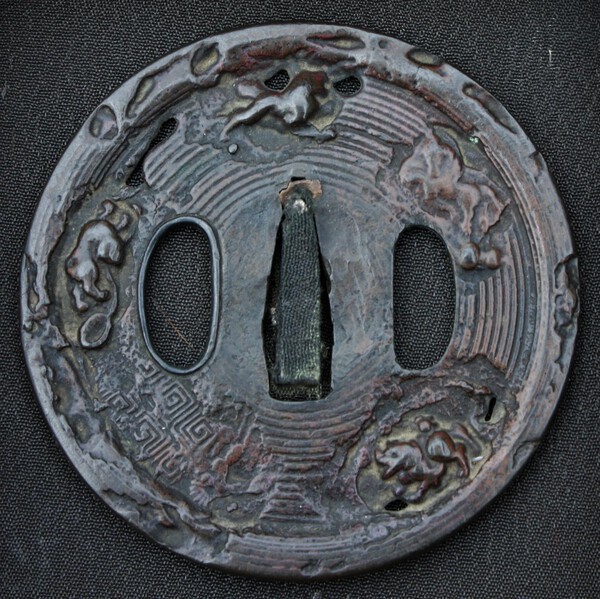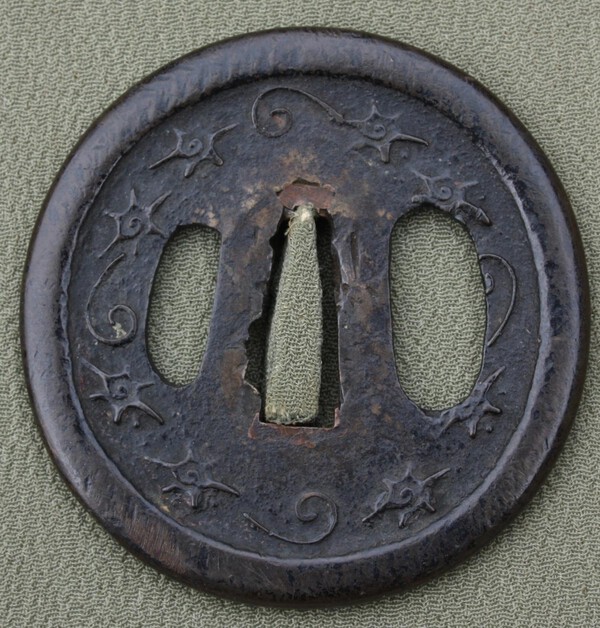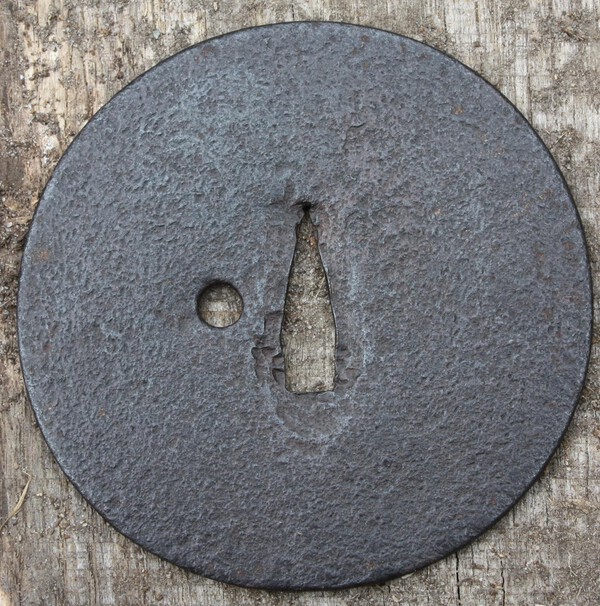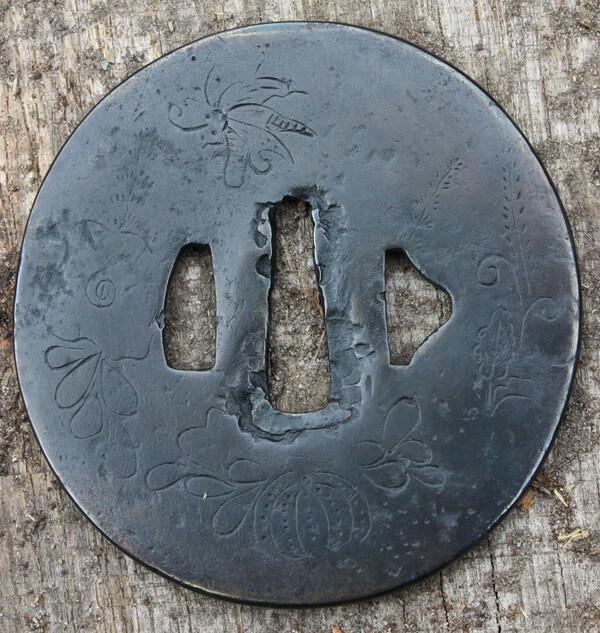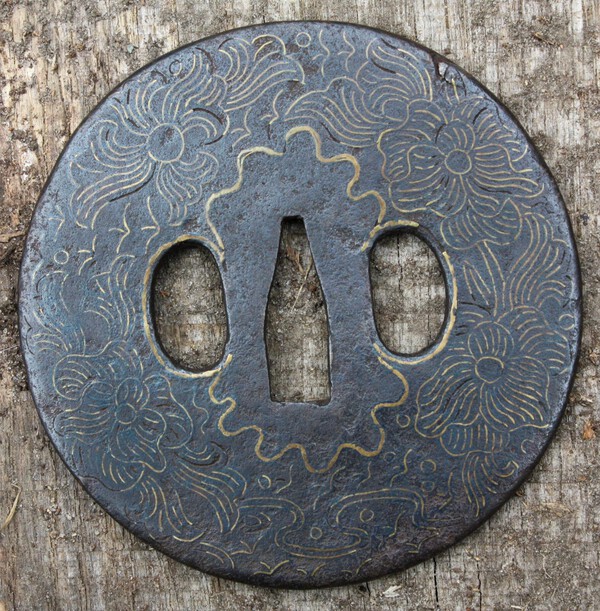-
Posts
290 -
Joined
-
Last visited
Everything posted by johnnyi
-
Thanks Curran, foryour stream of consciousness . Yes, you are right that the urushi could have been applied any time. When ever that time was, it seems to have been long enough time to wear most of the urushi away on the seppa dai. You're also right that I probably won't get anywhere until I can actually identify the urushi, if thats what it is, , and Nara expert seems like a good plan. For what it's worth, I re-measured the iron thickness again and it does taper all the way from the edge of the seppa to the edge of the tsuba, not just a taper near the tsuba. Roughly goes from 2.2mm to 1.5-1.8mm on the edge. Very thin, but not flat plate.
-
Thank you gentlemen for your comments. It is very interesting about the background "seppa" which I was unaware existed, but will now keep my eyes open for. This piece (which is slightly irregular and thus too crude for such a piece i think. A friend knowledgable in antiquities has suggested this morning that urushi is the coating. This would make sense of what we're seeing, and conform with what we're seeing. By the way, we are also seeing years of what looks like wax and dirt on the ura. The other side, face, has been cleaned apparently by the seller. Curran, my first instinct also leans to very old, but that could certainly be wrong. I must take better pictures, as there does seem to be some deeper intentional scoring in exposed areas around the ana, but deeper than what you'd see in normal cross hatching. Perfexct though for providing a base for a lacquer such as urushi. Still don't know much about this one.
-
These show a little better. It seems that there is a substance between the "gold" and the iron. Was there a cheap leaf that might have been adhered to paper , due to it's weakness maybe?, that was applied to the iron? I see in my picture one of those pesky "folds" is there too.
-
What a kind good bunch you are not to comment. It was pointed out to me that what I was seeing was a photographic illusion of a fold within the seppa. Boy, that changes everything I think. It might be old but maybe oldish. The gold leaf is however gold leaf and crudely applied within nakago. Thanks John
-
Hello. Hoipefully some of you can comment or enlighten regarding exactly what this piece is. It is iron measuring 80.7mm tall by 66.5 mm wide, by 1.8mm at edge and 2.2mm at dseppa dai. The tsuba appears to be covered with possibly a composite resembling gold, or some type of amalgam. I know it does not react to vinegar, nor is there any evidence of a corrosion of any kind. The plate itself appears to have been folded once (tosho style), as evidenced by wall of seppa dai. * it is unclear to me whether the coating , gold leaf, or whatever, was applied before or after the tsuba was fitted to the sword. My guess, due to the squarish seppa dai, is something perhaps Chinese or Korean. It has been suggested to me however, that it could be Tosho, but an unusual shape. Here are some pictures which refuse to show the glint of the covering: Thanks for your input JohnnyI
-
Thank you Kyle. This is a great help.
-
-
Roger, saw this last night. Perhaps not as old as yours but appears to be same theme TSUBA Sword Braces Round Collar | eBay regards, John I
-
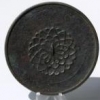
Metal detector and Nihonto
johnnyi replied to Blazeaglory's topic in General Nihonto Related Discussion
Please, what detector are you using? On certain settings iron will give you a false reading. You mentioned "on the bed" Are these on a neutral surface when you scan and not upon bed springs? (a round spring will give a false reading also) -
Hi Grev, I was under the impression that this was pine bark but it could be wrong. Good luck John
-
Very much enjoyed your article Peter.
-
Yes, an ox and bad artist 😬
-
Agree with Dale, a ram or goat beneath possibly a pomegranate tree (Japanese symbolism) johnnyi
-
Hello. Thanks for the very informative post John. If I can add just a couple of observations that you've already alluded to; First, the thickness. Joe, your tsuba seems to be slightly domed?...at least a bit thicker than John's. It is almost certain that when John's tsuba is held up and gently tapped it will ring like a bell. All of the real Saga Kaneiye tsuba I've held have this fine iron quality. On Joe's tsuba the top left stroke of the mei rides over the top left stroke. On all of my Saga Kaneiye tsuba which have passed Mr. Haynes' muster have the opposite overlap, as does John's which is real Saga Kaneiye. Another observation was pointed out here once regarding the mountains; the Saga mountain, it was said, comes to more of a point while the Shoami is rounded. Mr. Haynes said that the Saga Kaneiye is one of the areas which has not received the research that other schools have so you've got some fun ahead. . Regards, John
-
Here is an older tsuba which may fit the category. It is kagami-shi, probably early to mid Muromachi. Its wabi sabi aspects seem more literal than some others posted here, such as the obvious worm eaten mimi, and what seems to be the story of zen enlightenment and transience (culminating with the ox lying peacefully unbound upon the rope which originally confined him.) *this specific stamped die of the ox I've found on two other well known kagami-shi tsuba which are dated 1300's-1400's tentatively. jirwin
-

Oldest piece of Japanese art
johnnyi replied to kissakai's topic in General Nihonto Related Discussion
Thanks Mauro. Interesting tsuba! I was referring previously to Torigoye and Robert Haynes notes regarding the rows of ten zogan; "..early style has four rows of low brass dots,...later style there are but three..". I don't know if the row "rule applies at just the round ones or ones like yours and after seeing your new one, doubt it does. . Thanks J -

Oldest piece of Japanese art
johnnyi replied to kissakai's topic in General Nihonto Related Discussion
Mauro, those tsuba are all awesome! I wonder regarding your Onin, since it is thought that three row of zogan is younger than four row, then your five row is older still?? -

Oldest piece of Japanese art
johnnyi replied to kissakai's topic in General Nihonto Related Discussion
Its great see everyone's old tsuba and swords. Here are several of my oldest tsuba. The small Kagami-shi is the oldest, possibly followed by the large Tosho. Thanks for looking. Johnnyi p.s. yikes, the blow ups turned out bigger then expected! Brian, you have a contribution coming -
I like the first one johnnyi
-
Jean, Ford has kind of made saving the tsuba a non-issue with his thoughtful observations. As far as porosity is concerned though, of course iron isn't spongy, and "absorbed" was the wrong word for me to use perhaps so thankyou for correcting me. . Variations is surface, as well as chance of forging (surface lamination) fissures, indents, etc., absorbing melted mess was what I was referring to. John
-
Hi Dwain. I've bought several of these kind of things on ebay over the years, mostly fine hammered Shoami school on which someone had thought embellishment with a gaudy dove or crane or similar would somehow boost the value. Never have I encountered a flaw after basically "snapping off" the offending brass with a pointed stick of wood. In my cases it was a cheap glue that adhered the embellishments; something that easily chipped off the iron too with little effort. Although yours might be different, maybe it would be worthwhile to apply a little pressure from the side and see if yours snap off...before playijng with heat and a chance of causing glues to absorb into the iron tighter? Good luck John
-
Hi Colin. Is there a reason why it would not be Akasaka? Regards, JohnI
-
Hi Robert, someone here will know where a very useful composite of different hitsu ana is located on the board which hopefully will help date the kind of pendulous kozuka ana you have (I think momoyana if memory serves me). . I am no expert either, but it seems by the balanced shape of the the other one ( kogai ana ) might suggest that it was added later? regards, John
-
Hi Colin. It might be that the dragon is chasing the sacred pearl, and the cut is meant to depict that his jaws haven't closed upon it? Regards, John




.thumb.jpg.b9cc8b1c435894abbfecf33e168b4e9d.jpg)
